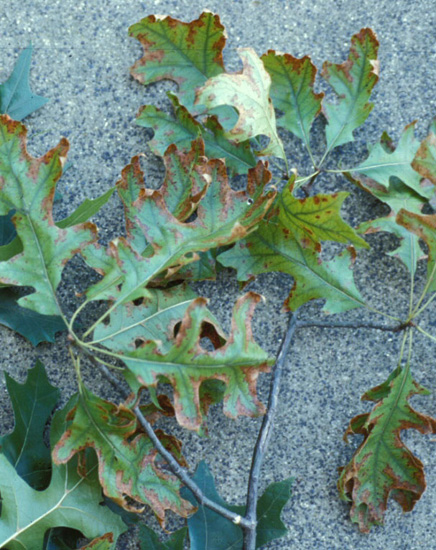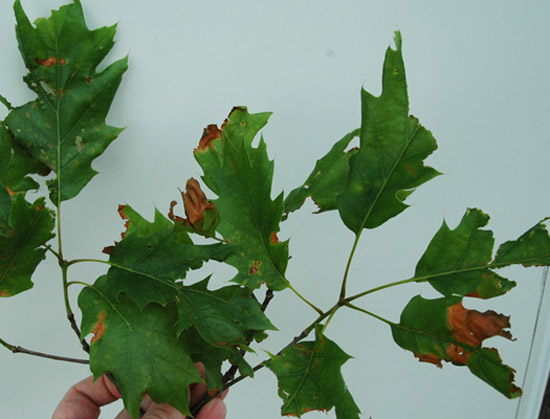Issue 3, May 7, 2010
Anthracnose Vs Environmental Stress
Many recent inquiries concern shade trees with tattered, spotted, and blighted foliage. Is this anthracnose, wind damage, frost injury, chemical damage, or something else? Anthracnose fungi invade in wet conditions. In the mid-section of the state, weather has been rather dry. On the other hand, infection only requires several hours of leaf wetness, so anthracnose is certainly a possibility. However, anthracnose has not been as common this season as last year. Anthracnose fungi are not picky about infection temperatures, infecting in most moderate temperature conditions. Hot, dry weather shuts down the disease.
Recent high winds and warm days followed by cool nights have triggered environmental injury on tender new leaves. We have seen some anthracnose this year. How can you know whether anthracnose or the weather is causing discolored, tattered foliage? Diagnosis is not always clear cut. Let's use oaks as an example. The first image shows oak leaves with typical environmental scorch. The necrosis is uniform and along the leaf edges. The tree was recently transplanted, has few established roots, and is present in an exposed location. Wind and sun desiccate leaf edges more quickly that roots can replace water, resulting in this uniform leaf scorch. The second image shows an oak earlier in the spring with tattered leaf edges. This is definitely a wind effect confirmed by missing leaf tissue and the pattern of worse injury on the wind-exposed side of the tree. In addition, this tree may have some anthracnose involvement. Sometimes anthracnose will cause tan areas of necrosis. If the areas seem to spread down a vein, anthracnose is more suspect. The last image is from an oak tree with only anthracnose. The blackened tissue, especially following a vein, is very typical of early season oak anthracnose. Tender new leaves are more susceptible to both wind and anthracnose. A report on anthracnose can be found on-line.



How do you know anthracnose is the cause? Look at the pattern on the tree. Anthracnose generally occurs in the lower portion of the tree where moisture is high and air movement and light low. Look for lesions scattered on the leaf blades. Anthracnose will cause some infection of the edges of the leaves, along the veins, and scattered on the blades. Should confirmation be necessary, a lab can use microscopes to see the fruiting bodies of the fungus. The fruiting bodies may be present in wet conditions. They will pop up on incubated tissue in as little as 12 hours.
In the case of shade trees, treatment is the same, whether the cause is anthracnose or environmental stress. Chemicals are not recommended for anthracnose of shade trees. In both cases, water the tree in times of drought stress to help it recover. Consider fall fertilization to give the tree a boost as well. No immediate action is required.
Still other cases involve the possibility of chemical injury, usually in the form of drift. In those cases the pattern and timing of symptoms is important. Chemical drift will affect many species and symptoms will be most severe on the side closest to the alleged source. Our lab is not equipped to test for chemical residues. Often residue information is not useful for trees because of a lack of data on injury thresholds. Even in the case of chemical drift, provide additional water in periods of drought to help the tree recover.--Nancy Pataky
Author:
Nancy Pataky